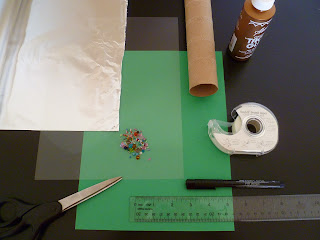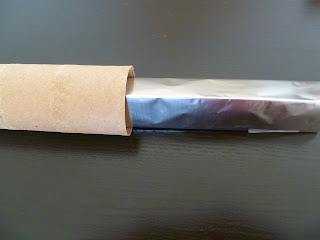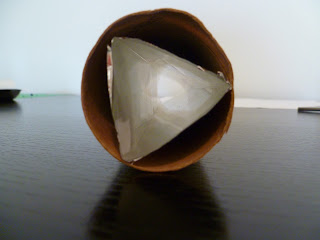Easy Kaleidoscope
This kaleidoscope is easy to make and kid friendly since it doesn't involved any sharp (or expensive) materials like mirror pieces. Chances are you will already have the following materials:
- sheet of transparency paper
- paper towel tube
- foil
- transparent and colorful beads
- a sheet of colorful construction paper
- glue or tape
- scissors
- a ruler
- a pen or marker
Use the pen to mark three dots 1 3/8" apart from each other.
Use the dots as a guideline to fold a triangular prism (lengthwise).
Trim off the extra of the transparency sheeting, leaving a small overhang. Tape along the overhang to secure the prism into place. Make sure that the folds in the transparency sheet are nice and crisp so an equilateral triangle is formed.
Wrap foil around the prism, shiny side facing inward. This piece will function as a mirror.
Insert the prism into the tube.
It should fit slightly loose. If it's too snug, the triangle shape will become distorted. Secure with a little tape or glue if needed. At this point, you could look through the tube and see reflections of the world around you.
Use one end of the tube to trace two circles onto the leftover bit of transparency paper.
Tape these two circles together 2/3 of the way to create a little envelope.
Fill with transparent beads. Ideally, the beads will be able to move around. Don't overcrowd the beads, and try placing one or two large beads in the middle so smaller beads will fall around them.
You could glue the bead packet into one end of the tube, but it should fit snugly inside. By not gluing it, you could create different packets with different colored beads, allowing you to change up your kaleidoscope at will.
If you don't have beads, drawing designs and patterns in a circle of transparency paper with colorful, permanent markers creates a similar affect.
Hold the kaleidoscope up to a light source and rotate it to see colorful, changing designs.
Here's a little science and geometry behind this kaleidoscope: Light
bounces off things in many direction, but it behaves differently when it encounters
a mirror. Light rays bounce, or
reflect, off mirrors in only one direction and at the same angle in which the
light hit the mirror. This angle that
light hits the mirror is called the angle of incidence, and the angle that the
light reflects from the mirror is called the angle of reflection.
Together,
the transparency paper and foil reflect enough of the light it receives to form
an image much like the original, thus functioning as a mirror. Since the transparency paper and foil
are folded into a triangle with equal angles and equal side lengths, they form
a prism of an equilateral triangle.
Since the three corners, or vertices, of a triangle form three angles
that equal 180°, an equilateral triangle has three 60° vertices. Each panel of the mirror is 60° from
the others. The light that enters
the kaleidoscope reflects off each of the three panels at 60°, forming eight
images.















